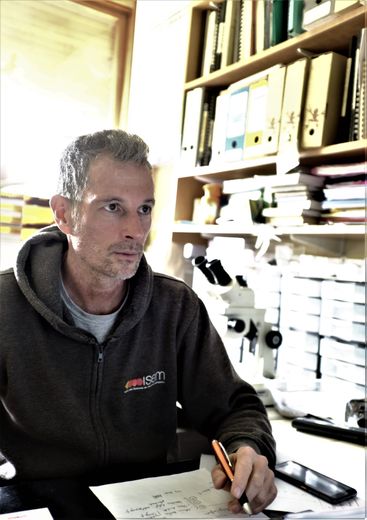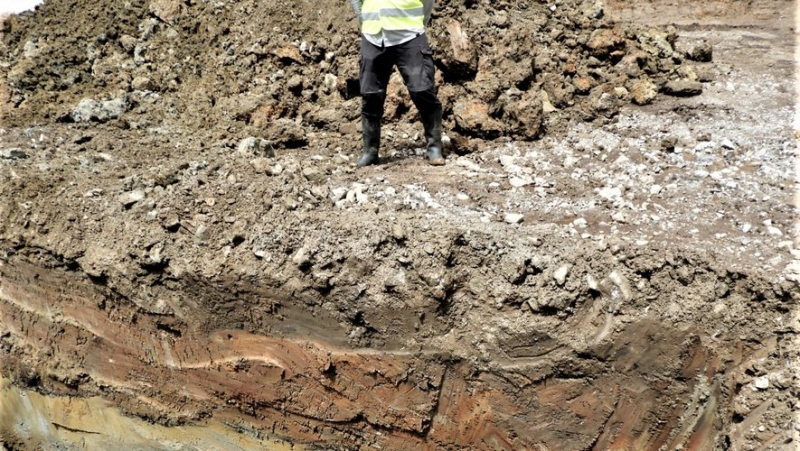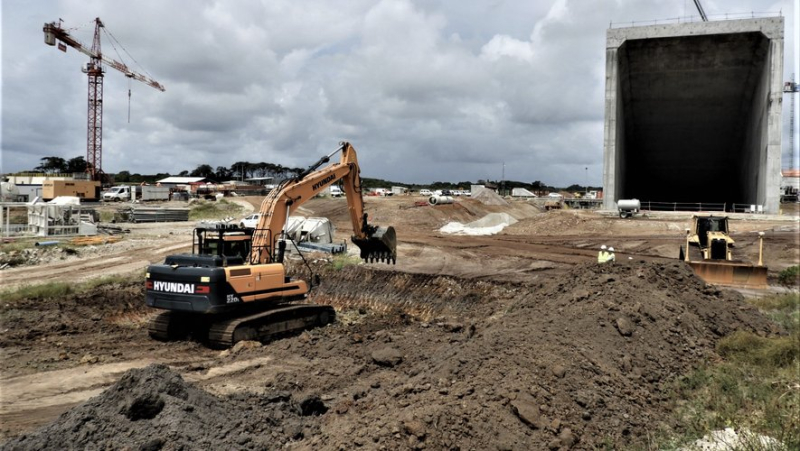Guyana 125,000 years ago revealed by Montpellier researchers


The Montpellier paleontologist Pierre-Olivier Antoine. Midi Libre – CODO

This is the type of oyster shell discovered by scientists on site. A mollusk allowing us to certify that at a time not so long ago, this piece of Guyana was underwater. P.-O. Anthony


This section allows you to see the sedimentary layers, with, at the bottom, the famous gray clay, a real temporal safe. P.-O. Anthony

The first excavation site was carried out within the confines of the future launch pad, then under construction, of the European launcher, in front of one of the two gigantic exhaust pipes. Two cathedral-sized tunnels, allowing gases from the combustion of fuel and oxidizer, and fumes, to escape. P.-O. Anthony
This unique work also reveals our near climatic future and has just been published in the journal “Proceedings of the National Academy of Sciences of the United States of America”.
Adjectives and qualifiers are lacking for the layman to summarize the amount of work and discoveries inherent in the project carried out, five years in a row, by the paleontologist and professor Pierre-Olivier Antoine at the University of Montpellier, associated with twenty-nine other scientists scattered across the globe. So how can we summarize this kind of compendium started in the fall of 2018 in the Kouroucian clay ?
Especially since this work had never before been carried out in the Caribbean arc. Scientist's word: "In October, we go there, we sieve and we find what we were hoping for: a great diversity of marine organisms. In there, we find sharks and fish, without knowing the age of these finds. We set up a project to raise funds and we return there the following year. But it’s super complicated to work."
Despite everything and over four days, the small team extracted half a ton of earth, a few meters from what was then the future launch pad of Ariane VI, the latest iteration of the European launcher.
Fifty kilos of material analyzed
five grams by five, binocularly
Fifty kilos of clay material are then brought back here, then passed through a microscope sieve, "five grams per five". A series of sleepless days and nights, the retinas glued to the binocular.
"We quickly realized that we had never heard of fossils in Guyana or Surinam, nor in Brazil& quot;.So, when crustaceans, molluscs, echinoderms, sea urchins, plants and all other forms are revealed in a microscopic state, found imprisoned in the gray clay matrix of the tropical subsoil , "we said to ourselves: This is a big deal! We then called on the best specialists in the world for each category."
"There, we say to ourselves that we have a great story!"
Il must then distribute the samples all around (or almost) the globe. The ace. The outbreak of Covid will create quite a mess. "We were a little desperate but finally we re-ran a campaign, five hundred meters from the first site (outside the space center enclosure, Editor's note). There we had one day to work and extracted 350 kilos."
In this earthy mass ?"This confirmed the first findings, dated in the meantime after a year of research which also made it possible to find hundreds of thousands of specimens of 230 species. We were then able to reconstruct the landscape with those who lived there. There, we had a great story! "
Discovery of the giant sloth: this other world first
At the same time, Pierre-Olivier and other researchers also carried out research. their scientific gaiters in the heart of the Amazonian forest, in the vicinity of Maripasoula, & In the fall of 2021, they went to gold panning sites. And there they discovered a world first. They indeed unearthed the remains of a sloth. Or those of a giant ancestor of this arboreal mammal. Which, in the prime of life, did not weigh between 3 and 8 kg but, at the very least, three tons!
In fact, the future mission, if its financing is completed (several hundred thousand euros necessary), should make it possible to confirm the presence of this plantigrade but also of elephants, tigers &agrav; saber teeth. Knowing that researchers were able to collect "DNA from seventy species of plants and animals such as the camel, call & ;eacute; here paléolama, disappeared eight thousand years ago".
From deoxyribonucleic acid to the yet passed &agrav; through the ages thanks to this same gray clay, a sort of temporal safe.
A snapshot of what's coming
with climate change
Three independent dating analyzes later, the results fall: "All bring back to 125,000 years and confirm our initial hypothesis:this corresponds to the last moment when the sea covered the shore before the last glaciation, before the ice age, between 100,000 and 200,000 years ago. Before that, this period of 125,000 years is super short, 10,000 years. It is two or three degrees warmer than today and the water is four to five meters above above the current level." This is a very serious analogy of what Guyana could be like by the end of the century with climate change.
Six years later, this singular and laborious enterprise has just resulted in an article published, at the end of March, in the journal Proceedings of the National Academy of Sciences of the United States of America.
That is, eleven pages to summarize the equivalent of a directory, then submitted to criticism before obtaining an imprimatur, a first of its kind. Because until then, no similar work had been carried out in this part of the world or on this scale. "This will make it possible to nourish models elsewhere. We already have hundreds of downloads from colleagues", specifies Pierre-Olivier Antoine.
Not a little proud but determined to continue further by setting up a new campaign, "a real big collaborative project to tell us the history of the coast and of the forest".
I subscribe to read more




